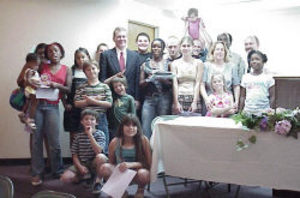In April 1999, I was honored with being chosen by a local non-profit agency to become a youth development specialist. I was chosen because of my social work and teaching experience with young people. Each of the surrounding three counties in the Jacksonville, Florida, area were also initiating the program at the same time. We merely were told it was a youth development program and were told what our budget was for the year. That was it. The rest was up to each youth development specialist creativity to figure out how their program would run.
For the first few months, I noticed that my fellow co workers in the surrounding counties merely took the youth on field trips as a means to spend the money. I would hold a monthly meeting on some important topic and very few children would show up. However, if i was to pay for a trip to see the Jaguar football game, everyone showed up. So thus my idea began. Why not make the youth work for their trips? Why not come up with some requirements for the youth in order to earn the wonderful free trips we were offering.
The first thing I did was decide on a monthly educational topic. The first month I chose drug prevention and connected with the local sheriff office who provided not only a sheriff to talk about drug prevention, but brought along a convict that was in prison for selling drugs. He was more than willing to share with the youth what drug addiction and selling drugs would do to a person’s life.
My next step was to think of some community service project that the youth had to perform in order to earn their free trip. Our first project was to connect with the local project to clean Florida’s rivers. We were given a section of the local St. Mary’s river to clean up. We were to turn in our bags full of garbage and in return, we were rewarded with a wonderful dinner at the local Kingsly Plantation.
The third step was to require the youth to bring me their report cards. In order to earn the trips, the youth had to maintain a B average. Anything lower than a B would make the child eligible for free tutoring, that we of course paid for by hiring a tutor to come to the center two days a week. If the child did not bring up their grades the next grading period, but did attend tutoring two times a week, they were once again eligible for the field trip.
It took about three months for the youth to figure out how the program worked. They were to attend a monthly meeting for three months, during that quarter, they would attend one community project where they donated at least four hours of community service. They also were to turn in their grades. If the child meet all three of these requirements, they then could go on the field trip. Not only did this policy ensure more participation in the monthly meetings, but it reduced the number of children that would attend each trip. On our first trip, before these policies were instituted, we had to hire a bus and a driver to take us to our field trips. On subsequent trips, we could take the agency 15 passenger van, which freed up even more money to use for the youth.
Every August, each child received free school supplies. In addition, we had a quarterly party or banquet of some type. Our Christmas program and banquet was held the third week of December. Our Spring Celebration or Easter program was held the week before Easter, usually the end of March. We held a family picnic each June, and our yearly awards banquet was held in September, as our budget year ran from October to September.
The last part of the program that I instituted, was to plan two yearly out of town trips to youth conferences. I did some Internet research to come up with these. I connected with a wonderful youth group called Youth Crime Watch. They started in the state of Florida, but have since expanded to other areas of the U.S. and even to some foreign countries. i also connected with a program called SWAT or Students’ Working Against Tobacco. Each organization held a yearly conference. many times, these conferences were out of state. The most responsible youth were chosen to go. I would only take those over 14, and I would take the ones who had attended the most meetings and had volunteered the most hours.
I returned to teaching full time in 2005 . I miss the youth I work with, but some of them still keep in touch. Hopefully, the program will continue and young people’s lives will continue to be changed by the program and future Youth Development specialists.
Reference:
- Experience



